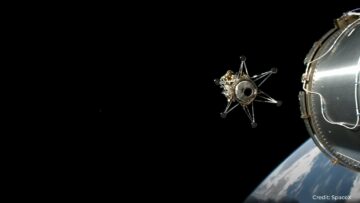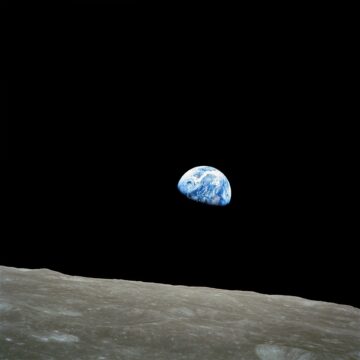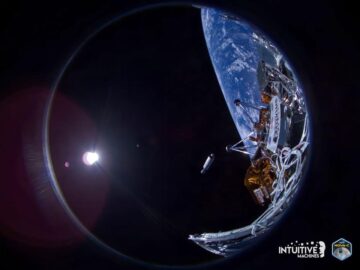by Leanne Ogasawara

1.
It was the first US lunar landing since 1972, when last Thursday a private Houston-based company successfully touched down in the lunar highlands 185 miles north of the moon’s south pole.
We are told again and again: space is hard.
I was born around the time of the first Apollo mission, when human beings walked on the moon. My childhood was filled with that magic, and by third grade I knew what I wanted to do with the rest of my life: I would become an astronaut. It took a surprisingly long time for me to grow out of my dream. And it wasn’t until junior high school that I realized I might not exactly have “the right stuff” for space. That was when my attention turned toward cosmology. I devoured countless books on the subject and that was when I received my prized Christmas gift from my parents: a lunar globe!
In those days, you could still see the Milky Way from our LA suburb… there were countless stars to train my eyes on as I spent hours staring up toward the heavens. But nothing captured my attention more than the glowing moon. And as a child, I was continually astonished that human beings had walked on its dusty surface. I couldn’t have imagined how our space program would have stalled like this. Or maybe I should put that differently. Back when I was dreaming of becoming an astrophysicist, I imagined we would soon have bases on the moon, doing research and preparing for the bigger mission:
But, yeah, space is hard. So far, five nations have achieved soft non-crewed landings on the moon: Russia, the US, China, Japan, and India. And now—as of Thursday evening, so has a private American company. Launched by a SpaceX Falcon rocket, Houston-based Intuitive Machines managed to set their gorgeous Odysseus lander down on the south side of the moon.
And guess who was there with them?
Yours truly! Well, not in the physical sense, but a poem I translated from the Japanese was included in the Lunar Codex Time Capsule. The invitation came as a wonderful surprise about a year ago when, having a bit of a dark drizzly November day in my heart, Samuel Peralta asked me if I wanted to be a part of his project.
I answered in a nanosecond: YES!
Samuel Peralta is a particle physicist, who is also a writer, an artist, and a visionary—and a new member of the Advisory Board of the Interstellar Foundation. Coming up with his Lunar Codex Time Capsule project during the dark days of Covid, he designed a time capsule to be put on a nanofiche disc that includes art, poetry, books, music, and film from over 30,000 contemporary creative artists in over 150 countries.
Awhile back, he and I collaborated on several translations of Japanese poet Takamura Kotaro’s Chieko Poems. The sculptor and poet Takamura Kotaro (1883-1956) is perhaps best known in Japan for his “Chieko Poems,” which are a chronicle documenting the evolution of the poet’s relationship with his wife, as well as a celebration of his love for her.
 2.
2.
“The Love which moves the sun and other stars…”
Oh, how happy I was that Samuel chose a poem from the early days of their relationship, when the two were deeply in love. My translation, which was first published in the University of Iowa’s journal of translation, Transference is copied below. Not unlike Voyager’s Golden Record, the content of the time capsule was stored on a nanofiche and attached to the Lander.
Before this, I had never really thought much about time capsules—though when I was a teenage camp counselor, one of the projects we played around with was creating one. The kids were supposed to write some notes and bring things that they felt they would want to find again later. Imagine, say, three or four decades in the future, what items and thoughts might be meaningful to dig up?
But not just that, for we encouraged the kids to think of the capsule as something going beyond a memory palace—as it was really a message! But a message for whom? A few kids wondered. Well, for your future selves and even for other people who might be there when it is discovered.
The most famous time capsule is the Golden Records placed on the Voyager Mission. The contents of the record were selected for NASA by a committee chaired by Carl Sagan and include over a hundred images and a variety of natural sounds, such as those made by surf, wind and thunder, birds, whales, and other animals. To this, they added musical selections from different cultures and eras, and spoken greetings from Earth-people in fifty-five languages, and a printed message from my beloved President Carter, who wrote these words:
This is a present from a small, distant world, a token of our sounds, our science, our images, our music, our thoughts and our feelings. We are attempting to survive our time so we may live into yours.

3.
According to the Dark Forest Theory, we should be very glad that we have not encountered alien life… because that encounter might not go so well for human civilization. The term comes from a series called The Three Body Problem by Chinese sci-fi author Liu Cixin.
In growing anticipation of the Netflix version of the book —I am re-reading it for my third time. And I still struggle to wrap my mind around the idea of people on earth who become so disheartened by what they see around them that they not only call—but they encourage and facilitate- extraterrestrials to come and wipe us out.
After I first read the book a few years ago, I was inspired and wrote a piece of flash fiction about two astronomers who are romantically involved but their different perspectives about “what is out there,” tear them apart. My husband is a Caltech astrophysicist and the male character is based on him—it is a seed of a story that I really want to develop someday.
Chris says, “In all the possibilities for intelligent life, there are two things they will likely share with us. The laws of evolution and liquid water.”
“You forgot resource scarcity,” I said. “That is also probable.”
In the Three Body Problem, the alien characters have much bigger trouble than just resource scarcity —since their planet is completely hostile to life! And so civilizations will rise, only to die back with each new period of unsustainable chaos. This is from the author’s after note:
There’s a strange contradiction revealed by the naïveté and kindness demonstrated by humanity when faced with the universe: On Earth, humankind can step onto another continent, and without a thought, destroy the kindred civilizations found there through warfare and disease. But when they gaze up at the stars, they turn sentimental and believe that if extraterrestrial intelligences exist, they must be civilizations bound by universal, noble, moral constraints, as if cherishing and loving different forms of life are parts of a self-evident universal code of conduct. I think it should be precisely the opposite: Let’s turn the kindness we show toward the stars to members of the human race on Earth and build up the trust and understanding between the different peoples and civilizations that make up humanity.
I am with Liu on this. Messages of peace are good— but broadcasting our location….?
Maybe not such a great idea.
From the point of view of the extraterrestrials in Liu’s novel, who have relentlessly struggled to survive on an extremely hostile and chaotic planet, our earth with its stable environment is a paradise. When the first alien learned of the existence of our earth, he found his thoughts drifting “over the blue ocean that never froze and the green forests and fields, enjoying the warm sunlight and the caress of a cool breeze. What a beautiful world! The paradise we imagined really exists!”
The aliens are right, our earth is impossibly beautiful.
 4.
4.
The other day, a friend couldn’t wait to tell me about a book. He was, he said, going through his old copies of the New Yorker and stumbled on a review by James Wood. He thought it would interest me. And he was right!
Samantha Harvey’s 2023 novel Orbital is a story that takes place over the course of one twenty-four hour period on the International Space Station, as six astronauts speed around the world in low earth orbit at seventeen-and-a-half thousand miles-an-hour. Circling the Earth sixteen times, they thus witness sixteen sunrises and sixteen sunsets (“the whip-crack of morning arrives every ninety minutes”) in twenty-four hours.
The book is a beautiful story illuminating what it feels like to orbit the earth two-hundred and fifty miles above the surface for six months in a cramped space with five strangers. That is what the story is about but what the book is ultimately writing is a love letter to the planet in the most gorgeous poetic prose you will ever read. Harvey writes that as they each go about their mundane tasks,
Before long, for all of them, a desire takes hold. It’s the desire – no, the need (fuelled by fervour) – to protect this huge yet tiny earth. This thing of such miraculous and bizarre loveliness. This thing that is, given the poor choice of alternatives, so unmistakably home. An unbounded place, a suspended jewel so shockingly bright.
 In Ascension, by Martin MacInnes, was my favorite book on this year’s Booker Prize longlist. It was really an ambitious work of literary science fiction that I totally fell in love with. The main character is a woman doing marine research on microbial archaea, which she later uses to try and turn algae into a foodstuff. This happens in her life around the time when there is a major technical advance realized by several different research groups simultaneously (!) around the world leading to the invention of an interstellar drive that can propel humans beyond the solar system—and so the researcher is tasked by a US company to develop the algae food for space travel. The company is also involved in plans to exploit asteroids for minerals and building off-planet bases for this. In doing so, people in the company noticed that one of the asteroids had begun to suddenly accelerate heading out of the solar system and more: that this asteroid was covered with strange carvings. Meanwhile the old Voyager spacecraft is also similarly accelerating out of the solar system much faster than theorized and has neared the inner edge of the Oort cloud —and so that’s where the mission is going to head!
In Ascension, by Martin MacInnes, was my favorite book on this year’s Booker Prize longlist. It was really an ambitious work of literary science fiction that I totally fell in love with. The main character is a woman doing marine research on microbial archaea, which she later uses to try and turn algae into a foodstuff. This happens in her life around the time when there is a major technical advance realized by several different research groups simultaneously (!) around the world leading to the invention of an interstellar drive that can propel humans beyond the solar system—and so the researcher is tasked by a US company to develop the algae food for space travel. The company is also involved in plans to exploit asteroids for minerals and building off-planet bases for this. In doing so, people in the company noticed that one of the asteroids had begun to suddenly accelerate heading out of the solar system and more: that this asteroid was covered with strange carvings. Meanwhile the old Voyager spacecraft is also similarly accelerating out of the solar system much faster than theorized and has neared the inner edge of the Oort cloud —and so that’s where the mission is going to head!
Like in Harvey’s Orbital, more than all the science-based twists and turns, this novel read like a beautiful love letter to the earth —from scenes of the rising water in Rotterdam and sea turtles and migratory birds dying en masse because they’re no longer able to make their migrations, much space is given to describing the physical and psychological strain of astronauts not just in leaving the earth, but leaving it totally behind as they can no longer see it as they head toward their rendezvous with voyager one. The astronauts long for earth, lovesick for it.
MacInnes wrote that, “I thought of In Ascension as a case for full human integration in the natural world… An attack against the assumption that humans are somehow outside the earth system… The book is an attempt to show humanity differently and more vulnerably.”
I would say that we are not just part of the earth system but part of the entire solar system— and maybe beyond.
As Duncan Lunan points out in his review in Shoreline of Infinity Magazine about the asteroid covered in weird carvings, Martin MacInnes is not the first writer to dream up an asteroid covered in mysterious writing:
In 1971-72 Jeff Hawke, the world’s longest-running SF comic strip, created and drawn for the Daily Express by Sydney Jordan from Dundee, ran a story called ‘Here be Tygers’, later reprinted in the first issues of Starburst in 1978. It began with the launch of the ‘Grand Tour’ TOPS probes, of which the Voyagers were a much scaled-down version. Decades later, a mission to Pluto is diverted because one of the TOPS probes unexpectedly turns back on to show images of a mysterious object on the edge of the Solar System. It’s covered with carvings in different languages – mostly nonhuman, but one of them is in an ancient Peruvian script, and when eventually recognized and translated, it warns that the object is one of a ring of markers, beyond which lurks a dangerous and savage race.
That dangerous and savage race is us.
🚀 🚀 🚀 🚀 🚀 🚀
Friday’s NASA Press Conference about Intuitive Machines’ Odysseus lander tipping over on the moon during ‘spicy’ lunar landing
Awakening on Winter Mornings (notes and original Japanese here)
On winter mornings
Even the River Jordan is covered with a thin layer of ice
In my bedroom wrapped up in my white blanket
I imagine how John the Baptist felt as he baptized Christ
I imagine how Salome felt as she held John’s severed head
On winter mornings the sound of wooden clogs
Echoes shyly from the street
Let me merge with nature’s immensity
Like the silently rotating constellations
I too must get moving
Then the sweet smell of mocha
Wafts into my room
Like a spirit reborn with eyes wide awake
At that moment I know
With the coolness of a mathematician
There are strange rhythms
Like waves rippling in our human world
Wake up, my love
On winter mornings
Songbirds will be singing outside your suburban home
For my love has opened her dark eyes by now
Stretching her arms like a young girl
Enjoying the beautiful morning light
I imagine her smiling as she listens to the songbirds singing
And seized by this moment
Tapping on my white blanket
I sing a hymn to love
On winter mornings
My heart is full
And I shout for joy
A pure and good life this is
The haze appears as gold dust
Across these amber blue skies
As an English Pointer begins barking in the distance
This yearning, this hunger arises
And before long, I am yearning for my love again
On winter mornings
I bite into the ice of the River Jordan
